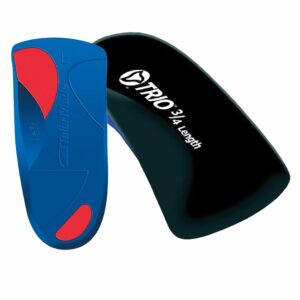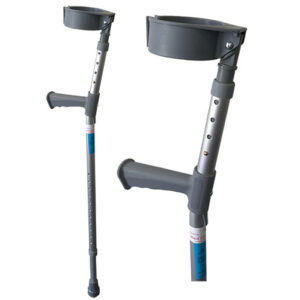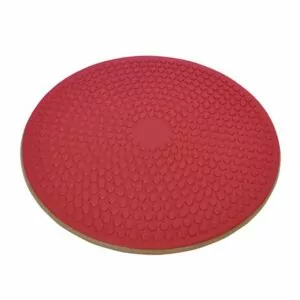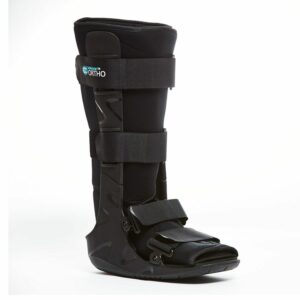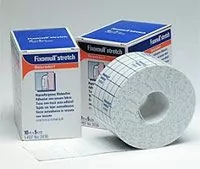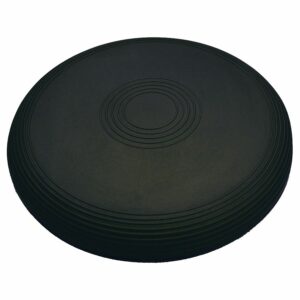Sprained Toe
Updated:
(Also known as Toe Sprain, Toe Injury)
What is a sprained toe?
A sprained toe is a relatively common condition characterized by damage or tearing of the connective tissue (such as ligaments, cartilage and joint capsule) of one or more toe joints.
Each of the toes (except the big toe) comprises of 3 small bones known as phalanges. The big toe only comprises of 2 phalanges. These small bones join to each other at the IP joints (Interphalangeal Joints) and to the bones of the mid foot (metatarsals) at the MTP joints (metatarsophalangeal joints). As a result, the big toe has 2 joints, whilst the remaining toes each have 3 joints (figure 1). Each of these joints comprises of strong connective tissue wrapping around the bony ends and cartilage which lies between the joint surfaces, cushioning the impact of one bone on another during activity.
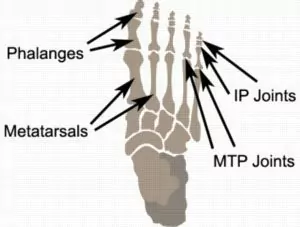
During certain movements of the toes (such as kicking an object with the toes or stubbing a toe), stretching or compression forces are placed on the toe joints. If these forces are excessive due to too much repetition or high force, injury to the joints may occur. This may involve damage to the cartilage or tearing to the connective tissue surrounding the joint. When this occurs, the condition is known as a sprained toe and may affect one or more IP or MTP joints. The big toe is the most commonly affected, particularly at the MTP joint. This injury is known as a first metatarsophalangeal joint sprain.
Causes of a sprained toe
Sprained toes are relatively common in sports (particularly on non-slipping surfaces) and frequently occur due to a specific incident such as a hyperextension force (excessive backward bending of the toe) or a hyperflexion force (excessive forward bending of the toe e.g. a stubbed toe). A sprained toe may also occur in contact sports (due to collision with another player), in kicking sports or in martial arts. Occasionally, a toe sprain will occur due to repetitive strain associated with overuse. This may be the case in patients who perform repetitive activities involving end of range movements of the toes. Sprained toes are commonly seen in sports such as gymnastics, dance, athletics, and football.
Signs and symptoms of a sprained toe
Patients with a sprained toe often experience a sudden onset of toe pain during the causative activity. However, patients may also experience pain and stiffness after the provocative activity with rest (particularly at night or upon waking the following morning). Symptoms may be felt on the front, back or sides of the affected joint. Occasionally pain may be referred into the foot on the affected side. Symptoms are generally exacerbated with activities that place pressure on the affected joint such as walking (especially up or down hills, on uneven surfaces or with change of direction), running, kicking, jumping or standing on tip toes. It is also common for patients to experience pain on firmly touching the affected joint. In more severe cases, swelling or bruising may be present and in some cases, the patient may walk with a limp.
Diagnosis of a sprained toe
A thorough subjective and objective examination from a physiotherapist is usually sufficient to diagnose a sprained toe and to determine the likely structures affected. An X-ray, however, should be performed in most traumatic cases to exclude a fracture. Further investigations such as a MRI or CT scan may be required to confirm diagnosis and rule out other injuries.
Treatment for a sprained toe

Members Only ContentBecome a PhysioAdvisor Member to gain full access to this exclusive content. For more details see Become a Member. Already a member? Login Now
Prognosis of a sprained toe
In cases of a minor to moderate toe sprain, return to sport or normal activity can usually occur in 2 – 6 weeks with appropriate management and treatment. Patients with a more severe injury will usually require a longer period of rehabilitation to gain optimum function.
Contributing factors to the development of a sprained toe
Although a large number of toe sprains are unavoidable, there are some factors which can increase a patients’ likelihood of experiencing a sprained toe or suffering a recurrence. These factors need to be assessed and corrected with direction from a physiotherapist and may include:
- poor proprioception or balance
- inadequate rehabilitation following a previous toe sprain
- joint instability
- muscle weakness
- poor core stability or a lack of co-ordination
- joint stiffness
- inadequate warm up
- inappropriate or excessive training or activity
- inappropriate training surfaces
- poor biomechanics or foot posture (e.g. flat feet)
- decreased fitness or sport specific conditioning
- fatigue
- inappropriate footwear (such as soft, flexible shoes)
Physiotherapy for a sprained toe
Physiotherapy for a toe sprain can hasten the healing process, ensure an optimal outcome and reduce the likelihood of recurrence. Treatment may comprise:
- soft tissue massage
- electrotherapy (e.g. ultrasound)
- anti-inflammatory advice
- joint mobilization
- dry needling
- the use of crutches
- toe taping
- the use of a Cam Boot
- ice or heat treatment
- exercises to improve flexibility, balance and strength
- hydrotherapy
- education
- biomechanical correction
- the prescription of orthotics
- footwear and activity modification advice
- a gradual return to activity program
Other intervention for a sprained toe
Despite appropriate physiotherapy management, a small percentage of patients with this condition do not improve adequately and may require other intervention. When this occurs the treating physiotherapist or doctor can advise on the best course of management. This may involve further investigation such as an X-ray, CT scan or MRI, pharmaceutical intervention, corticosteroid injection, the use of crutches or a protective boot (Cam Boot) or a review by a specialist who can advise on any procedures that may be appropriate to improve the condition. A review with a podiatrist for the prescription of orthotics and appropriate footwear advice may also sometimes be indicated.
Exercises for a sprained toe
The following exercises are commonly prescribed to patients with this condition. You should discuss the suitability of these exercises with your physiotherapist prior to beginning them. Generally, they should be performed 3 times daily and only provided they do not cause or increase symptoms.
Your physiotherapist can advise when it is appropriate to begin the initial exercises and eventually progress to the intermediate, advanced and other exercises. As a general rule, addition of exercises or progression to more advanced exercises should take place provided there is no increase in symptoms.
Initial Exercises
Foot and Toe Up and Down
Move your foot, ankle and toe up and down as far as you can go without pain and provided you feel no more than a mild to moderate stretch (figure 2). Repeat 10 times provided there is no increase in symptoms.
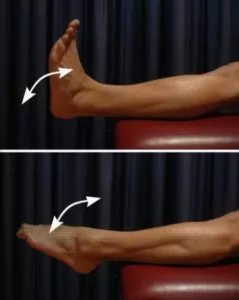
Foot and Ankle In and Out
Move your foot and ankle in and out as far as you can go without pain and provided you feel no more than a mild to moderate stretch (figure 3). Repeat 10 times provided there is no increase in symptoms.
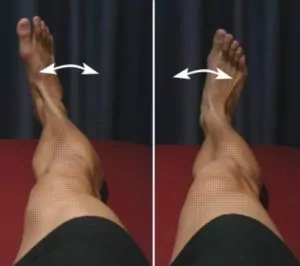
Foot and Toe Circles
Move your foot, ankle and toes in a circle as far as you can go without pain and provided you feel no more than a mild to moderate stretch (figure 4). Repeat 10 times in each direction provided there is no increase in symptoms.
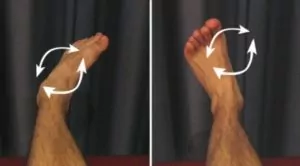
Intermediate Exercises

Members Only ContentBecome a PhysioAdvisor Member to gain full access to this exclusive content. For more details see Become a Member. Already a member? Login Now
Advanced Exercises

Members Only ContentBecome a PhysioAdvisor Member to gain full access to this exclusive content. For more details see Become a Member. Already a member? Login Now
Other Exercises

Members Only ContentBecome a PhysioAdvisor Member to gain full access to this exclusive content. For more details see Become a Member. Already a member? Login Now
Rehabilitation protocol for a sprained toe

Members Only ContentBecome a PhysioAdvisor Member to gain full access to this exclusive content. For more details see Become a Member. Already a member? Login Now
Physiotherapy products for a sprained toe
Some of the most commonly recommended products by physiotherapists to hasten healing and speed recovery in patients with this condition include:
To purchase physiotherapy products for a sprained toe click on one of the above links or visit the PhysioAdvisor Shop.
More Exercises
- View more Foot and Ankle Stretches.
- View Foot and Ankle Strengthening Exercises.
- View more Leg Stretches.
- View more Leg Strengthening Exercises.
- View Balance Exercises.
More Information
- View detailed information on How to use Crutches.
- View detailed information on when to use Ice or Heat.
- View detailed information on initial injury management and the R.I.C.E. Regime.
- View detailed information on Choosing a Shoe.
- View detailed information on Do I Need Orthotics?
- View detailed information on a Return to Running Program.
- View detailed information on Return to Sport.
- View detailed information on Foot Taping.
- Unsure of your most likely diagnosis? View our Foot Diagnosis Guide
Find a Physio for a sprained toe
Find a Physiotherapist in your local area who can treat this condition.
Become a PhysioAdvisor Member
-
 Individual Membership (12 Months)$59.95 for 1 year
Individual Membership (12 Months)$59.95 for 1 year -
 Individual Membership (3 Months)$39.95 for 3 months
Individual Membership (3 Months)$39.95 for 3 months -
 Individual Membership (Yearly)$49.95 / year
Individual Membership (Yearly)$49.95 / year -
 Individual Membership (Monthly)$15.95 / month
Individual Membership (Monthly)$15.95 / month

Link to this Page
If you would like to link to this article on your website, simply copy the code below and add it to your page:
<a href="https://physioadvisor.com.au/injuries/foot/sprained-toe”>Sprained Toe – PhysioAdvisor.com</a><br/>PhysioAdvisor offers detailed physiotherapy information on toe injuries such as a sprained toe including: causes, signs and symptoms, diagnosis, treatment, exercises, rehabilitation guide, physiotherapy products and more...
Return to the top of Sprained Toe.

